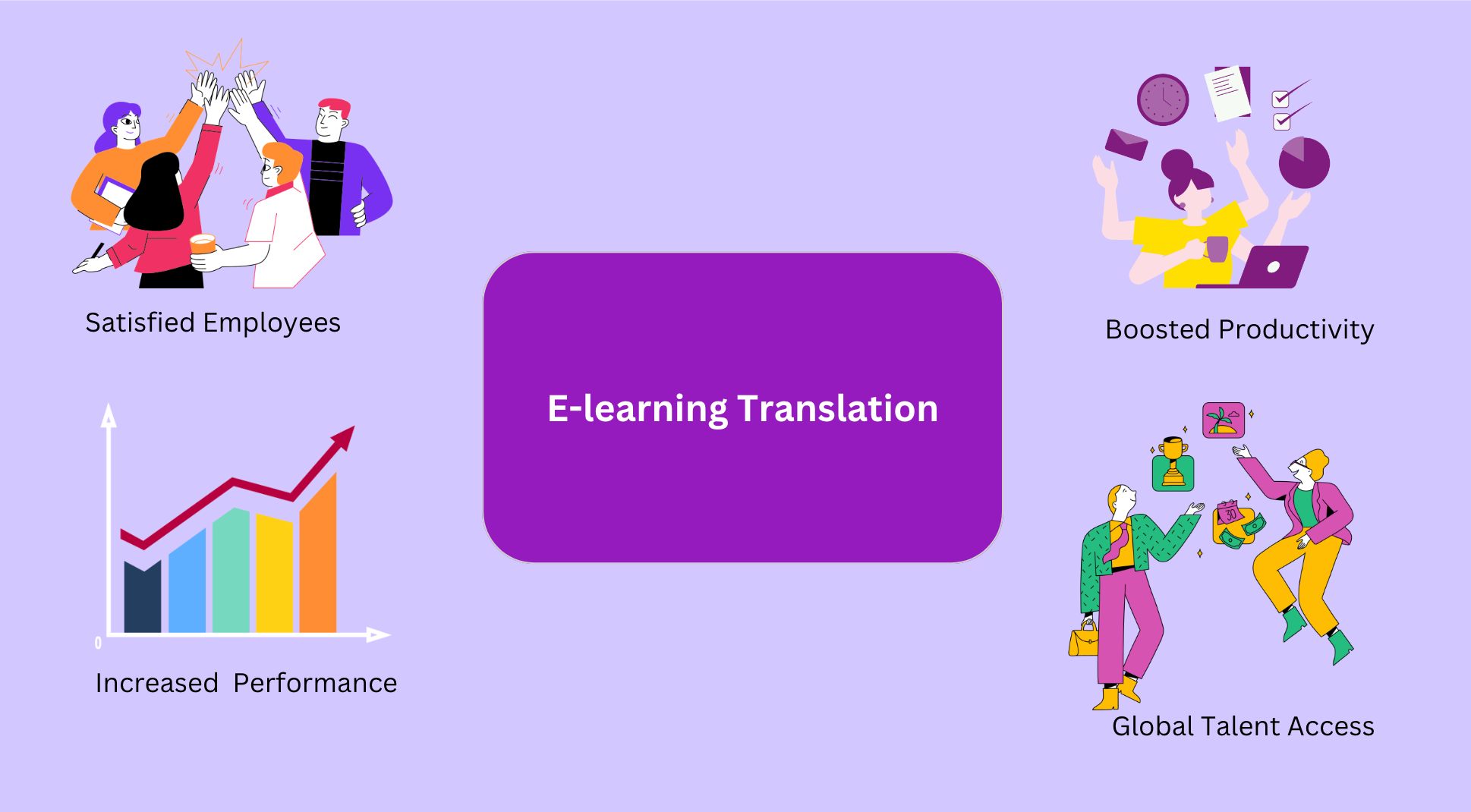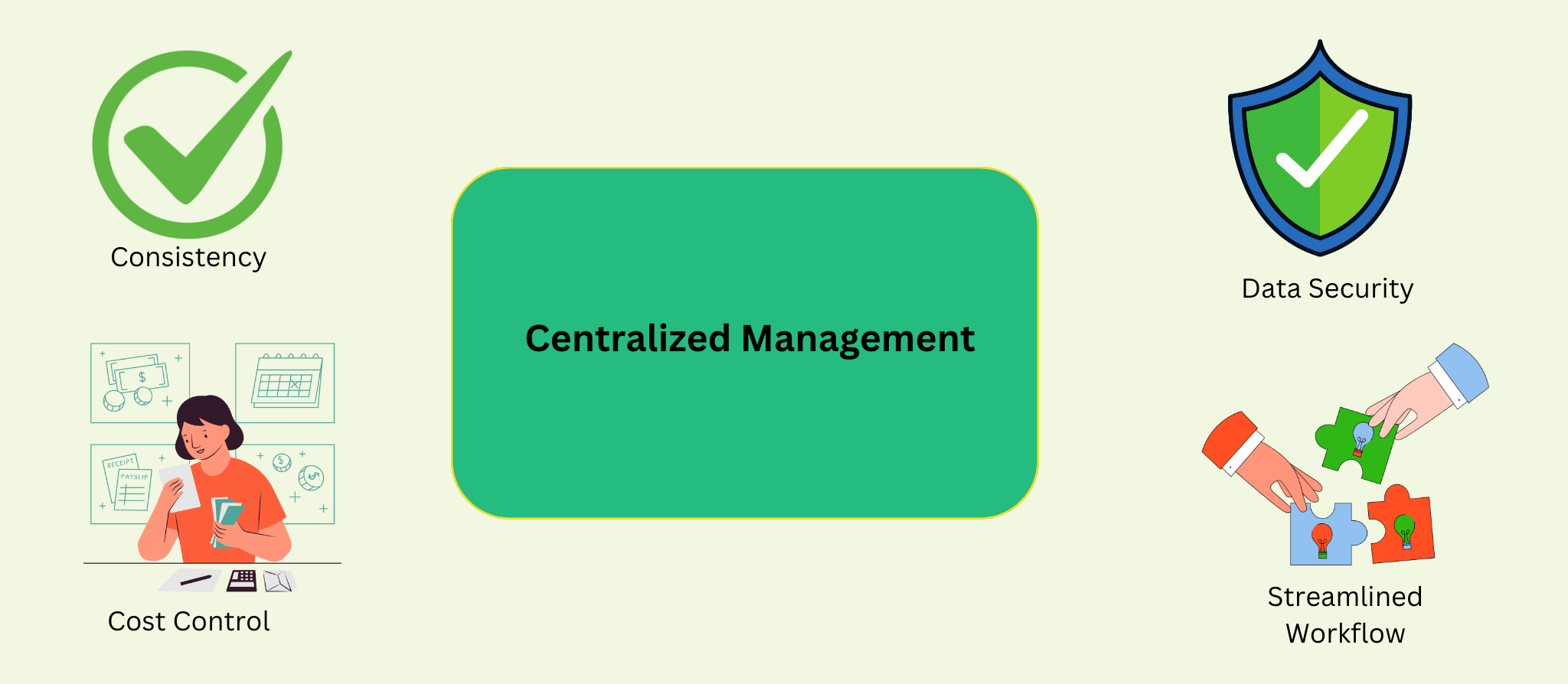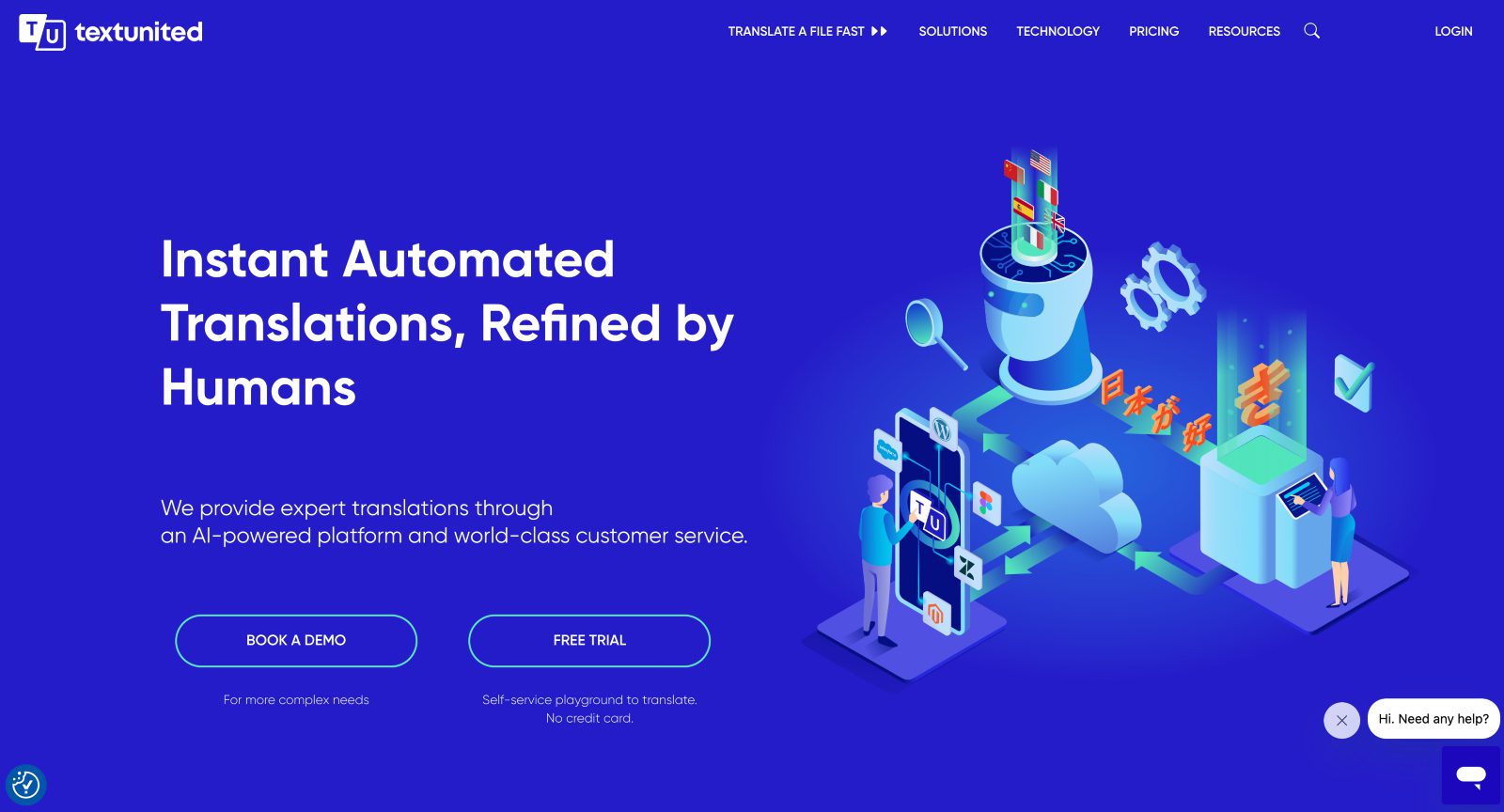Most large corporations and businesses handle content in various, including documents, videos, audio, images, graphics, and user interface elements. These materials serve multiple purposes and are often used in e-learning translations that can be accessed online. For example, they are crucial for employee onboarding, skill development and compliance training. Additionally, support product training, leadership programs, and remote learning.
In 2020, during the COVID-19 pandemic, many global corporations prioritized making their learning materials available online. This shift was driven by the need for effective communication through various media channels. Maintaining productivity and business operations required these efforts while employees worked from home. They needed to communicate with clients and the global workforce. Additionally, reaching sales and customer support partners and onboarding new hires remotely was essential.
This reality or need led them to seek translation services so that all their content and learning materials could be made available to a broader audience or global talent from different parts of the world.
With this new development, businesses needed to decide how to manage their translation: whether to do it centrally from one location (centralized approach) or locally (regional approach). This realization drove curiosity and the need for answers to this question, which we will discuss in this article!
Why do you need E-Learning Translations?
Following the spike in the number of global corporations that went remote during COVID-19 and began making their e-learning materials accessible to their staff online, these companies realized the door of benefits that translating their e-learning materials and making them accessible to a global talent brought to them.
When we say “e-learning translation,” we mean that these companies sought translation services to convert their e-learning content or materials from one language to another. So, for instance, if they had an online training course, a video to be specific, that was in German and needed to make it available to their English-speaking staff, they would have to translate the course to English.
So, what are the benefits of e-learning translation? Let’s see a few.

Illustration showing some benefits of E-learning Translation
E-Learning Translations Can Satisfy Your Employees
When onboarding new hires in your international company, it’s essential to recognize their diverse cultural backgrounds. For instance, providing training in their native language is a key factor in the success of the onboarding process. This localization, which considers local culture and circumstances, not only shows the company’s respect for its workforce but also significantly enhances the training’s effectiveness.
Suppose your company is based in France, and you want to onboard new hires from countries where French is not the primary language. How can you ensure effective communication for a crucial training program in this scenario? The solution lies in translating and even localizing your e-learning program. This could involve using examples and relevant references to their culture and language.
Research carried out and documented in ResearchGate, quote on quote, says:
“Culture influences what social norms individuals recognize and what behaviors they believe they should or should not perform. Whereby cultural work values differences that Culture influences can affect individual performance and predict job satisfaction in the workplace (Matić, 2008; Shafiq & Qureshi, 2014; Zaman et al., 2011).”
Translating all training courses for your employees guarantees a deep understanding of the material. It leads to clear communication and brings a sense of respect and value, ultimately winning their hearts.
Boosting Productivity with E-Learning Translations
In any company with staff from different parts of the world with different cultures working remotely, productivity can be easily hampered. Why? Communication is critical and determines the speed at which information is understood enough to carry out a task successfully.
In such a global environment, a task in one department can depend on many other functions in other departments. So, if the team members across the various departments struggle to communicate or understand the information being passed, it can affect productivity.
A study by the Human Resource Management Academic Research Society found that 65% of companies face language barriers, and 40% report decreased productivity due to these barriers.
The importance of e-learning translations for multinational companies cannot be overstated. Providing translated training programs and content such as documents and PowerPoint presentations can significantly improve employee performance. With high-quality translation services like TextUnited, you can enhance productivity and empower your team in ways never thought possible.
Increasing Performance with E-Learning Translations
A boost in productivity naturally leads to increased performance across all departments. Regardless of cultural or language differences, when materials are relatable and engaging, employees can learn effectively in their native language. This results in improved performance.
E-Learning Translations Can Help You in Contacting Global Talent
For an international company, it’s not enough to put out job posters; there are certain factors you need to consider in the job market to achieve your goals of hiring the right talent.
Among many things global talent looks at before choosing to join a company is “Does this company take cultural diversity into consideration?” or “Does this company have things in place that accommodate cultural diversity?”.
A study by Deloitte says:
“Deloitte found that the proportion of executives who cited inclusion as a top priority rose by 32% from 2014 to 2017. Sixty-nine percent of executives rated diversity and inclusion as an important issue.”. This research also noted, “Cultivating and showcasing an inclusive culture is an essential component in talent strategies, and can result in increased creativity, productivity, and innovation.”
You wouldn’t want to miss out on hiring global talent that can drive success because your company lacks cultural diversity measures, would you?
You may wonder why these global talents care about this; the reason is simple: they want to feel seen and heard. You can achieve that by simply speaking to them in their language, achievable by e-learning translations.
Who Should Manage E-Learning Translations in Your Company?
Now that we’ve discussed the importance of e-learning translations, who should manage this process? Let’s discuss.
You can do this in two ways: Centralized management (HQ) and Regional Management by Subsidiaries. Choosing between these two is not as simple as it seems at first sight; we’ll discuss each of them, including their pros and cons.
Centralized Management (HQ)

Illustration showing some benefits of Centralized Management
When we say “centralized management”, we refer to a situation where the headquarters of your company controls and oversees all the translation projects so that all the translations meet the company’s standards while remaining consistent across all the regions that fall under the company. So, it’s as simple as it sounds.
Pros of Centralized Management (HQ)
This approach of managing translations at your company’s headquarters comes with its perks. Let’s look at some of them.
- Keeping Your Linguistic Assets Up to Date: If your company has specific industry key terms to be used across all regions, you can set up central glossaries and style guides. Centralizing these assets ensures they are current and consistently used across all translations, saving time and maintaining uniformity.
- Breaking Departmental Silos of Language Data: Using a centralized system, all translated phrases and terms are shared across appropriate departments through translation memories, preventing data isolation. This fosters collaboration and ensures all departments benefit from shared language resources.
- Better Control Over the Confidentiality of Data: Centralized management enforces strict data security measures to protect sensitive information, reducing the risk of data breaches and ensuring compliance with data protection regulations.
- Better Control Over Overall Spending on Translation: Centralizing the budget for translation allows your company to monitor and manage costs more effectively, avoiding duplicated efforts and negotiating better rates with vendors.
Cons of Centralized Management (HQ)
Like with every approach, some disadvantages always come with it. So, let’s look at a few:
- Initial Effort Needed to Implement a Centralized Management System: Setting up centralized system requires significant planning, resources, and training, which are time-consuming and potentially costly.
- May Lack Local Expertise If Needed: Centralized teams might not have the same understanding of local languages and cultures as regional teams, leading to translations that may not fully resonate with local audiences.
- Challenges in Communication and Bottlenecks in Project Management: Coordinating between HQ project manager and various departments can lead to delays and miscommunications, slowing down the translation process.
- More Difficult to Maintain Quality: Ensuring consistent quality across multiple regions can be challenging, especially without local human resources dedicated to quality assurance tasks.
Regional Management by Subsidiaries

Illustration showing some benefits of Regional Management
From the word “regional”, think about your regional offices or local subsidiaries handling your translation projects. So, it is an approach that involves leveraging regional expertise and know-how and local talent to meet localized needs. Like the centralized management approach, regional management also has perks and disadvantages. Let’s look at some below.
Pros of Regional Management by Subsidiaries
- Better Access to Expert Linguists at a Lower Cost: Regional offices can hire local translators who are experts in the specific local language and culture, often at a lower cost. This results in more accurate, culturally appropriate translations.
- Greater Flexibility: Managing translations regionally deals with a smaller scope compared to central management, allowing for more flexibility and faster decision-making. These translations are adaptable to local needs and lead to quicker turnaround times.
- Shorter Decision Chains: Regional managers can make decisions without waiting for approval from the headquarters (HQ). This results in more relevant and faster decision-making.
- Addressing Regulations and Cultural Content Better: Due to their smaller scope of responsibilities, regional teams have a better understanding of cultural nuances and local regulations, ensuring cultural appropriateness and compliance.
Cons of Regional Management by Subsidiaries
Now, let’s look at some disadvantages of this approach to managing your e-learning translations.
- Duplication of Efforts: Multiple regions working independently on similar translations can lead to duplicated work (work related to document layout and formatting, preparation of video subtitles, etc.) and higher costs. This is a potential challenge that needs to be managed effectively.
- Prone to Inconsistencies: Different regions might use different terminology (specific terms or vocabulary) and styles, leading to inconsistencies in brand messaging and quality.
- Loss of Linguistic Data: Language data might be stored locally and not shared with other regions or HQ, leading to missed opportunities for reuse and learning, including reuse by AI systems.
- Minimal Transparency: As the translation project progresses across various regions, it can become difficult for the headquarters to have enough visibility into the progress, increasing the risk of missed deadlines and project delays.
An Example of a Company That Uses TextUnited for E-Learning Translation
During the unprecedented challenges posed by the COVID-19 pandemic, the e-learning platform Articulate experienced a surge in demand as organizations increasingly turned to it for developing comprehensive workplace training programs. With the shift towards remote work and virtual learning, many companies searched for robust localization program to effectively deliver their online content and training courses to diverse audiences.
In response to this need, these organizations came across TextUnited. This advanced AI translation platform provides instant automated translations and allows human refinement to guarantee the highest quality and speed for the training program content created in Articulate. This innovative solution offered the flexibility and efficiency required to swiftly adapt training materials to various languages while maintaining accuracy and relevance.
Translating Articulate content with TextUnited begins by exporting the content from Articulate in XLIFF or XML formats. These formats allow for easy extraction of the text for translation. Once the content is exported, it is uploaded to TextUnited for translation. TextUnited’s professional translators work on the automatically translated content, ensuring accurate and high-quality translations.
After the translation is complete, the translated files are imported back into Articulate. This seamless integration allows the translated content to be directly utilized within the Articulate platform. Additionally, all translated content is securely stored in the client’s TextUnited account, making it easily accessible for future translations or updates.
By utilizing TextUnited for the translation process, clients can benefit from efficient, accurate, and consistent translations for their Articulate training program content while maintaining a centralized repository of translated materials for future use.
Now, Articulate, through TextUnited’s system and translation services, can provide its clients with faster turnaround times that improve the translation quality and also help them adapt the content culturally, which will invariably boost the impact of their e-learning programs.
Other organizations like Plexus entrust TextUnited with translating their e-learning training programs material. Typically, Plexus’ subject matter experts initiate the translation projects, which TextUnited then oversees through its managed service offering. The translation involves various content types, including text, video, and audio, and providing voice-over translations when necessary.
How Can TextUnited Help Your Company with E-learning Translation?
TextUnited has a proven track record of delivering high-quality translation services. They are backed by successful projects and positive testimonials from satisfied clients. Dive into our case studies to see for yourself what companies and organizations have to say about their experience with us: Rosenbauer, ALN Africa, CATS, University of Lincoln, e-learning for kids, COSA, European Resuscitation Council, and Schrack Technik.

A Screenshot of TextUnited’s Website
Our team can handle your diverse content, including text, video, and audio, ensuring your e-learning materials are accurately translated and culturally adapted. We can help you achieve a smoother localization workflow, just as we assist the Articulate system in translating content exported in formats such as XLIFF and XML and generating translated files that can be easily re-imported. Whether you need translation or multimedia content localization, TextUnited is ready to provide a reliable solution that adapts to your company’s needs.
How to engage professional translation services for your company?
Now that you’ve gotten to this point, you might have enough information on why translation and localization of your e-learning materials is essential and the approaches you can choose from for managing your e-learning translations, either centralized or regional management. Now is the time to consider how to implement translation and localization strategies in your organization. If you’re seeking expert guidance and the best solutions, check out translation platforms like TextUnited. Click this link to book a demo with an expert today!
Get Answers to Frequently Asked Questions related to E-learning Translations
Additional Resources
Here are some resources you may find helpful:
- E-learning Translation: A Short Introduction
- Enhance Your Global Reach with TextUnited Video Translation
- Customer Spotlight: e-Learning For Kids
- Deciphering Translation Management Systems
- Translation Software Transformative Impact on Business Models
- AI Translation for Better Localization
- Website Localization Tools – How to Choose the Best One
- Localization Vs. Translation: Understanding the Nuances
- Getting Started with Website Localization
- Key Considerations for Translation Software
- How to Optimize Translation Workflow
- Localizing Training Material & Courses
- How to Choose the Best Localization Platform
- How Translation and Localization Services Can Transform Your Business

